Hummingbirds generally like to hang out in warm places like Mexico and the southern US, and who can blame them? But despite the cold winters, several of the 16 hummingbird species that live in North America will visit New York state.
That means whether you’re an active bird watcher or you just love hummingbirds, in particular, you have many opportunities to see these fascinating birds.
Hang up your feeder and get your checklist out.
Here is the list of species of hummingbirds in New York:
- Ruby Throated Hummingbird
- Broad-Billed Hummingbird
- Anna’s Hummingbird
- Calliope Hummingbird
- Rufous Hummingbird
5 Types of Hummingbirds in New York
Hummingbirds visit every part of North America, but New York is lucky enough to have four vagrant species that pop in once in a while and one common one. Here are the five species to watch for:
1. Broad-Billed Hummingbird
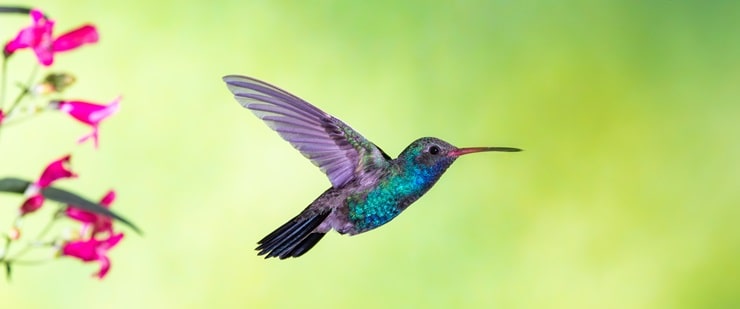
- Scientific name: Cynanthus latirostris
- Size: 3.5 inches long
- Weight: 0.1 ounces
- Wingspan: 4.3 inches
The broad-billed hummingbird makes Mexico and a few parts of the Southern US such as Arizona and New Mexico its home. It stays year-round in Mexico, but ventures further north during the breeding season.
This bird has a long, narrow, straight bill and a tail with a notch at the center, which helps you tell it apart from other species. They also stand out because of their shimmering green bodies and blue throats on the males. The bills are red with a black tip.
They eat insects as well as nectar from flowers and feeders.
These birds create their nests in mountain canyons and then head to higher elevations to forage after raising their young. The males court the females with a swooping display that has been compared to the swinging of a hypnotist’s watch.
There are five sub-species but only the magicus sub-species lives in the US.
When Do They Arrive In and Leave New York?
This is a rare, accidental species in New York. You never know when you’ll see them.
2. Ruby Throated Hummingbird
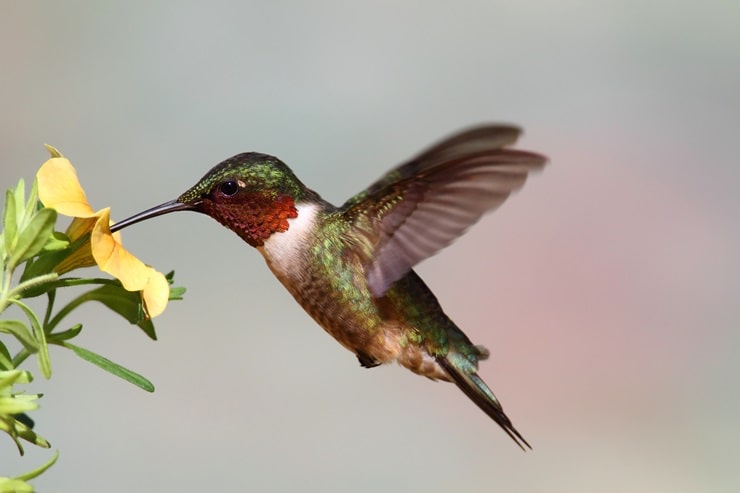
- Scientific name: Archilochus colubris
- Size: 2.8-3.5 inches long
- Weight: 0.1-.02 ounces
- Wingspan: 3.1-4.3 inches
Say “hello” to the most common – by far – hummingbird in all of New York. In fact, this is the only breeding hummingbird in the eastern part of North America.
The male birds are easy to identify by their bright red throats. If you notice a bird that looks somewhat like a ruby-throated, but the throat looks dark red, it’s likely just because the feathers aren’t in good light. Wait until the sunlight hits them, and you’ll see that shining bright throat.
Otherwise, these birds are emerald or golden-green on their backs and grayish-white on the underside. The beaks are black.
These bold birds are frequent visitors to feeders and if you have the chance to watch their antics, take it. They are incredibly agile. They can stop instantly in the air, hover up, down, side-to-side, and backward. Not only do they feed at feeders and in tubular flowers, but they’ll snatch insects out of the air or from webs, as well.
These generalists live in parks, gardens, backyards, meadows, fields, forests, and woodlands.
They fly away in the fall to winter in Central America and they actually fly across the Gulf of Mexico in one single flight without stopping. Very impressive!
When Do They Arrive In and Leave New York?
Ruby-throated hummingbirds are the only non-migratory hummingbirds in New York. They prefer warmer regions, but they aren’t scared to hang out even in the colder months.
You can see them during the breeding season throughout New York, which takes place from April to October.
3. Anna’s Hummingbird
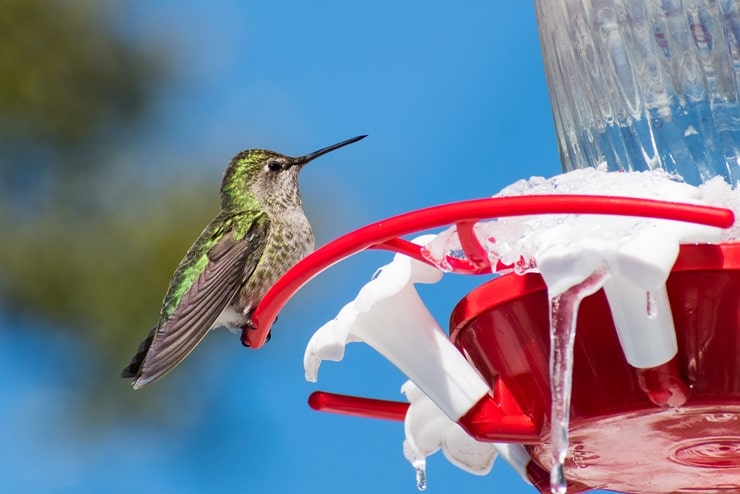
- Scientific name: Calypte anna
- Size: 3.9 inches long
- Weight: 0.1-0.2 ounces
- Wingspan: 4.7 inches
If you live along the Pacific coast, then no doubt you’ve seen the stunning Anna’s hummingbird. They’re one of the most common species in the region and they live there all year long. They’ll also travel inland a bit during the breeding season and some will migrate to Mexico during the non-breeding season.
Look for greenish-gray birds with iridescent feathers. Males have reddish-pink chins and heads.
When they’re breeding, the males will swoop down up to 130 feet, making a buzzing noise with their tail feathers in an attempt to impress the females.
These birds are bold and curious and will come right up to humans to check them out. They’ll eat at feeders, snatch insects, and suck the sap of tubular flowers.
When Do They Arrive In and Leave New York?
If you live in New York, it’s rare to see these birds. They’re only spotted once every few years.
4. Calliope Hummingbird
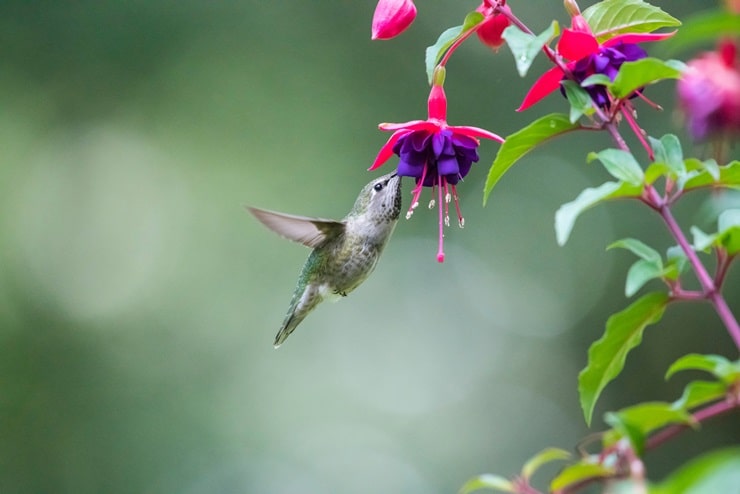
- Scientific name: Selasphorus calliope
- Size: 2.8-3.9 inches long
- Weight: 0.07-0.1 ounces
- Wingspan: 4.3 inches
Calliope hummingbirds are super uncommon in New York, but you might get lucky and see one of these non-natives visit any area of the state. If you do, make sure to brag to your friends! They’re far more common in the Pacific Northwest, California, parts of the west, and Canada.
They breed in western Canada, Oregon, Washington, California, Nevada, Idaho, Montana, Wyoming, and parts of Utah and they spend the non-breeding season in Mexico.
The males of these beautiful birds have magenta feathers on their throats and both females and males have iridescent green feathers on their backs. The male courts the female by diving in an acrobatic u-shape while making a buzzing sound with his tail feathers. They breed from April to June.
While they will eat from feeders, they tend to be a bit shyer than some other hummingbirds. They aren’t afraid of other birds, though. They’re even known to chase away red-tailed hawks.
They’ll eat the sap from flowers, but they’re also fond of the sap on trees left by sapsuckers and they’ll also eat insects and spiders.
When Do They Arrive In and Leave New York?
These tiny birds, the smallest hummingbirds in North America, are an accidental, rare species in New York.
5. Rufous Hummingbird
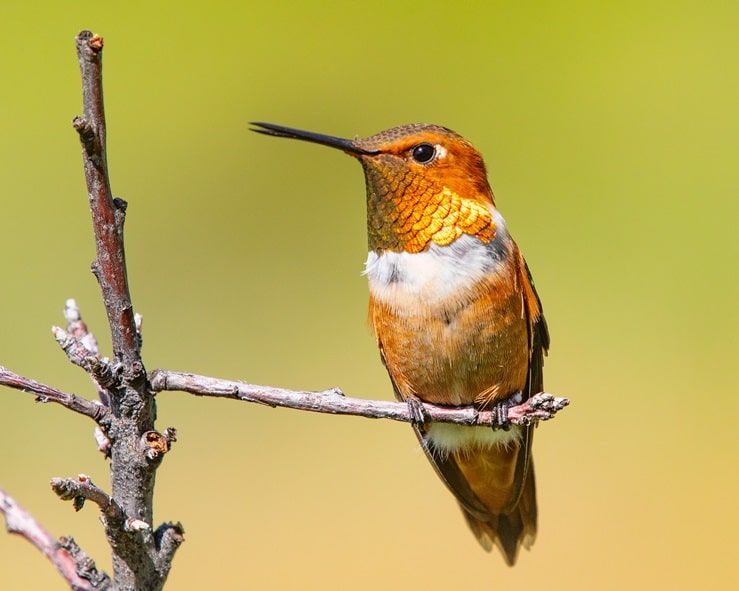
- Scientific name: Selasphorus rufus
- Size: 2.8-3.5 inches long
- Weight: 0.1-.02 ounces
- Wingspan: 4.3 inches
Rufous means “reddish” and that’s what these birds are. When the sunlight hits them, they glow like a lump of burning coal, with a reddish back and a vivid red throat. The females have a little bit of green on their tails and flanks, plus a little spot of orange on their throats.
Even though these birds might just be visiting an area as they migrate, they’re fierce defenders of the area they are in. They will tirelessly chase off any hummingbird that dares come near. They’ll even chase off bigger birds of other species and they’ll dive-bomb humans who come too close to their feeder or nest.
Like ruby-throated hummingbirds, they’re incredibly agile and will feed from feeders and tubular flowers, as well as snatch insects from the air or spider webs. They live in backyards, forests, meadows, and parks.
In the spring, they leave to their breeding grounds on the west coast where they stay from April to July.
When Do They Arrive In and Leave New York?
These hummingbirds aren’t common in New York. They have only been seen a few times in the past decade.
How to Attract Hummingbirds
To attract hummingbirds to your yard, pick feeders that have a little perch so you can observe them holding still as well as in flight.
Contrary to common belief, the feeder doesn’t have to be red. These birds don’t care about the color, they just want a nice meal. You can grab a beautiful feeder with perches from Bolite. Don’t die the nectar, either. Clear nectar is totally fine.
You can also use pre-made nectar to attract them. Just be sure to change the nectar frequently and wash the feeder out with hot water and soap. When it’s really hot, you should change your feeder daily. During cooler weather, once a week is fine.
Feeders left uncleaned develop a mold that can kill hummingbirds.
You should also plant stuff like firebush, fuchsia, honeysuckle, trumpet vine, and powder puff trees. Hummingbirds love these.
Other Species of Birds in NY:
Woodpeckers in NY
Owls in NY
